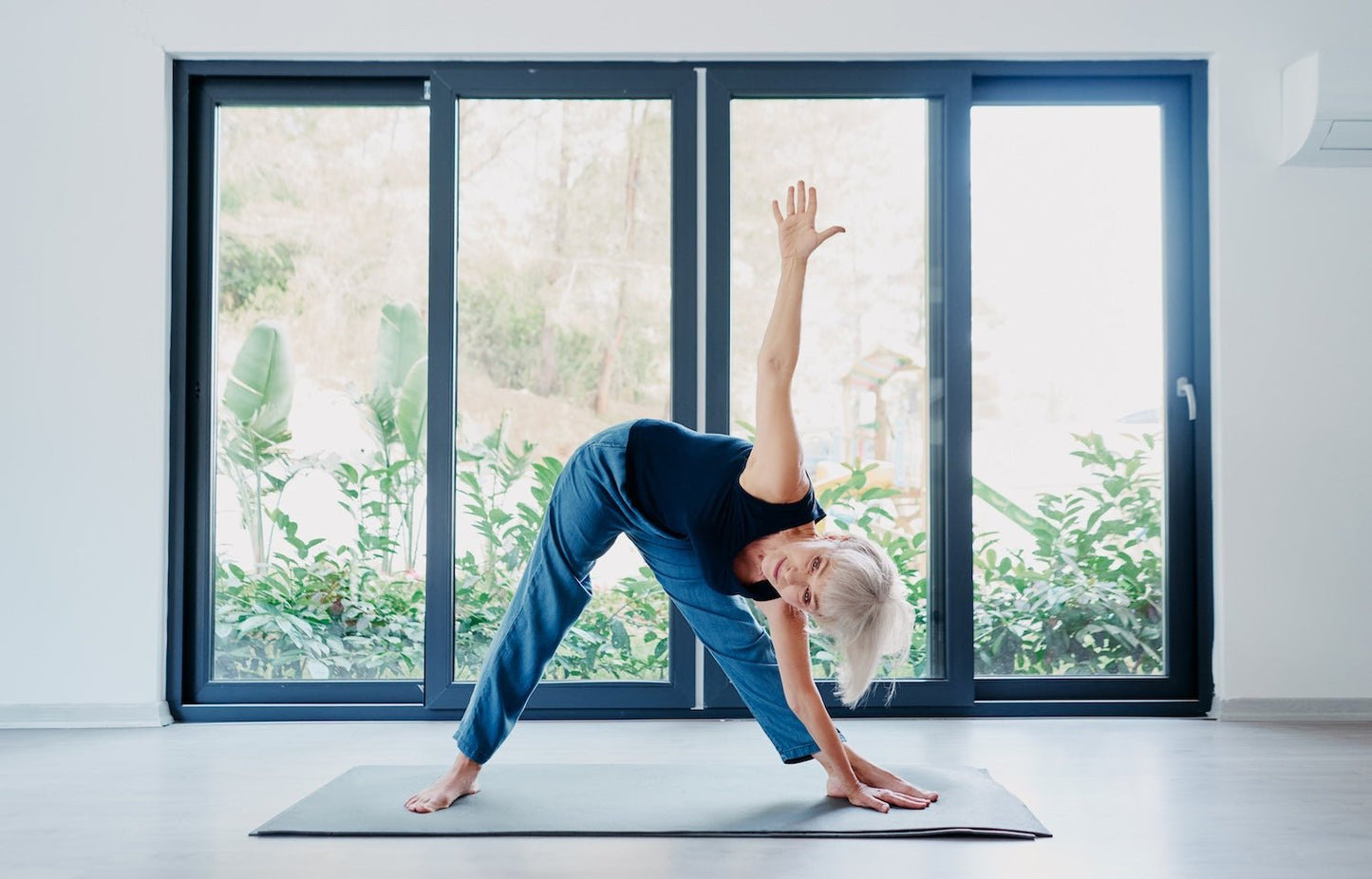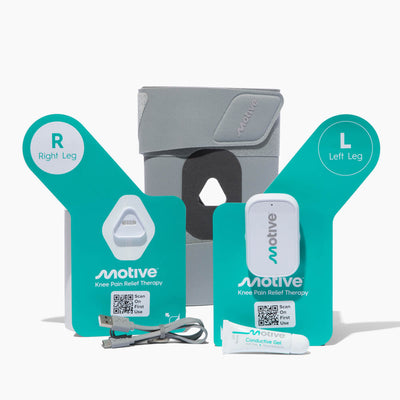
As you enter your 40s, it's not uncommon to experience increased knee discomfort. That first creak when climbing stairs or the unexpected stiffness after sitting too long can be your body’s not-so-subtle reminder that your knees aren’t what they used to be.
As we age, our knees take the brunt of decades of movement, so proper knee care isn’t just important but necessary for mobility and quality of life. While knee pain might seem inevitable after 40, the truth is that combining strategic exercise with innovative technology can improve knee health and reduce discomfort.
Studies show that 25% of adults experience chronic knee pain, with osteoarthritis being the leading cause for individuals 50 or older. This pain doesn’t just affect physical health but can also limit activities and reduce independence and overall well-being.
In this article, we’ll go over how your knees change after 40, exercises to maintain knee health, how Motive’s technology can upgrade your knee care routine, and the practical lifestyle tips you need to know to keep your knees functioning optimally for years.
Common Knee Changes After Age 40
As you enter your 40s, you might begin to notice changes in your knees, even with a history of being active and healthy. Understanding these changes is the first step to addressing them.
Physiological Changes
After 40, the cartilage that cushions your knee joints naturally starts to thin and lose elasticity. Combine that with decreased production of synovial fluid (the lubricant of your joints), and you get stiffness and reduced shock absorption.
The muscles that support your knees also weaken if not exercised regularly, creating a perfect recipe for knee discomfort.
Furthermore, osteoarthritis, the most common type of arthritis that affects knee joints, becomes more prevalent after 40. This degenerative condition is caused by the gradual wear and tear of cartilage, causing pain, swelling, and decreased mobility. Other conditions like rheumatoid arthritis, tendinitis, and bursitis also become more common during this stage.
Why is Muscle Support Important?
Strong muscles, especially the quadriceps and hamstrings, act as shock absorbers and stabilizers for the knee joints. When these muscles weaken, your knee joints bear more pressure with every step, accelerating cartilage deterioration and pain.
Research shows that strengthening the muscles around the knee joint can reduce pain in people with knee osteoarthritis. This muscle building creates a support structure that reduces stress on the joint itself.
Why Motive?
Modern technology offers modern solutions for knee health after 40. While exercise remains crucial, sometimes traditional methods can be challenging or insufficient for targeting the specific muscle weaknesses contributing to knee issues.
Individuals may find it difficult to perform exercises correctly or consistently due to pain or limited mobility. This is where innovative approaches that directly target muscle strengthening without stressing the joint become invaluable.
Motive’s FDA-cleared therapy is a game changer in this space, a way to strengthen the muscles around your knees without adding stress to the joint. This solution uses advanced muscle simulation to gently activate and strengthen the key muscles that support the knee joint, such as the quadriceps and hamstrings.
How to Take Care of Your Knees with Exercise
Regular movement is critical for keeping your knees healthy after 40, but choosing the right exercises makes all the difference between helping and potentially harming your joints.
Low-Impact Exercises
When you have knee pain, you need to choose low-impact exercises that don’t stress your knee joints but still give you cardio and muscle building:
-
Swimming: The water supports your body weight, so there’s minimal impact as you strengthen your leg muscles.
-
Cycling: Whether outdoors or on a stationary bike, cycling builds knee-supporting muscles with minimal joint stress.
-
Walking: Getting your steps in is a simple but effective exercise that strengthens your legs and improves circulation without the impact of running.
-
Elliptical training: Time on the elliptical is a solid cardio workout that involves your feet remaining in contact with the pedals, so there is minimal joint impact.
These exercises keep the joint moving and strengthen the muscles around the knee.
Strengthening Exercises
Targeted strengthening of the muscles around your knee is essential for joint stability:
-
Straight leg raises: Lie on your back, one leg straight, the other bent. Raise the straight leg 12 inches and hold for five seconds. Repeat 10-15 times on each leg.
-
Wall sits: Stand with your back against the wall, feet shoulder-width apart. Slowly slide down until your knees are at a 45-degree angle. Hold for 30-60 seconds.
-
Partial squats: Stand holding onto a chair for support. Bend your knees slightly, balancing your weight on your heels. Don’t bend beyond a 45-degree angle.
-
Step-ups: Using a step or platform, step up with one leg and then the other leg, then step down. This strengthens both the quadriceps and the muscles that stabilize the knee.
When you do these exercises, focus on form, not reps or weight. Start with what’s comfortable and gradually increase intensity as you get stronger.
Flexibility and Range of Motion
Flexibility helps prevent stiffness and supports full knee function:
-
Hamstring stretches: Sit on the floor with one leg extended and the other bent. Reach towards your toes until you feel a gentle stretch in the back of your thigh.
-
Calf stretches: Stand with your back to a wall with one foot behind you. Keep your back leg straight with the heel on the floor as you lean forward.
-
Quadriceps stretches: Stand holding onto a chair for support. Bend one knee and bring your foot towards your buttocks; hold your ankle with your hand.
Hold for 30 seconds without bouncing, and do these three times a week. Flexibility reduces stress on your knee joints when you move.
Motive: Technology-Enhanced Knee Care
As we explore how to care for knees after 40, advancements in technology have expanded the options beyond traditional methods. For example, Motive Knee can be the solution you’ve been looking for.
Motive’s FDA-cleared therapy targets one of the root causes of knee pain—muscle weakness—by strengthening the muscles around the joint. Unlike treatments that just mask symptoms, Motive strengthens the muscles that support your knee.
It works by delivering precise stimulation to activate and strengthen muscles around the knee, which can be especially helpful for adults 40+ who may be experiencing natural muscle atrophy. Our technology helps to support the structure around your knee joints, reducing pain and improving function.
Motive’s therapy also complements your existing exercise routine by targeting muscles that are hard to activate through exercise alone. This targeted approach can help you get stronger, more stable knees faster.
The at-home application means you can use Motive while reading a book, watching TV, or even working at your desk. The app allows you to personalize your therapy with adjustable stimulation levels to match your individual knee pain and comfort.
For adults 40+, Motive users report improvements in everyday activities like climbing stairs, walking longer distances, and participating in recreational activities with less pain. Over 20,000 people have experienced stronger muscles and reduced discomfort so they can stay active and do the things they love.
As clinical studies have shown, strengthening the muscles around the knee joint can reduce pain and improve function for people with various types of knee pain, including osteoarthritis.
Creating a Knee-Friendly Lifestyle
Beyond targeted exercises and technology, your overall lifestyle plays a significant role in keeping your knees healthy after 40.
Nutrition and Weight Management
Every extra pound adds 4 pounds of pressure to your knees when walking. Losing weight and maintaining a healthy lifestyle are some of the best ways to reduce knee pain and slow down joint deterioration.
A balanced diet rich in anti-inflammatory foods can help manage joint pain:
-
Fatty fish like salmon and mackerel have omega-3 fatty acids that may reduce inflammation.
-
Colorful fruits and vegetables have antioxidants that protect joints.
-
Nuts and seeds have healthy fats and vitamin E.
-
Whole grains have fiber and nutrients without the inflammation of processed foods.
Reducing sugar, refined carbs, and red meat can also reduce inflammation, which causes joint pain.
Getting enough vitamin D through safe sun exposure, foods, or supplements helps bone health, which benefits your knees indirectly. Staying hydrated also keeps the lubricating fluid in your joints and cartilage soft and supple.
Listening to Your Body
Pain is your body’s way of telling you something needs attention. Temporary discomfort during activity is normal, but persistent or increasing knee pain means you should talk to your doctor.
The RICE protocol (Rest, Ice, Compression, Elevation) can help with occasional flare-ups, but don’t ignore warning signs like swelling, instability, or pain that wakes you up at night, which may indicate it’s time to see a doctor. Early intervention often leads to better outcomes and can prevent further damage.
You should also know when to modify your activities. On days when your knees feel extra sensitive, consider switching to lower-impact exercises or using knee braces. Avoid high heels and opt for supportive, flat shoes during daily activities.
Long-Term Commitment
Consistency is key when it comes to knee health. Building daily habits that protect your knees, whether that’s a quick stretching routine, using Motive Knee, or being mindful of how you move, lays the foundation for long-term joint health.
Remember, knee care isn’t just about addressing current pain. You also need to focus on preventing future problems.
Even if your knees feel fine today, implementing these habits now will help ensure they stay that way as you age.
Take Control of Your Knee Health with Motive
Taking care of your knees after 40 doesn’t have to be a losing battle against the inevitable effects of aging.
Combining physical therapy, targeted exercises, proper nutrition, and innovative technologies like Motive’s therapy, you can strengthen the thigh muscles that support your knee joints, reducing pain and improving function.
Remember, small, consistent actions yield the biggest results.
Start with gentle exercises that strengthen your thigh muscles without straining. Maintaining a healthy weight can also reduce pressure on your joints as you age. Consider how advanced solutions like Motive can enhance your knee care routine by targeting the muscles around your knees.
Your healthy knees have carried you through decades of life’s adventures—now it’s time to give them the attention they deserve.
Visit Motive to learn more about our FDA-cleared therapy and how it can work with your knee care routine to help you stay active and comfortable for years to come.





